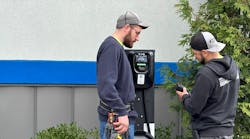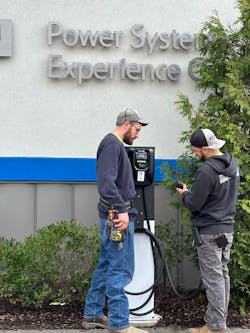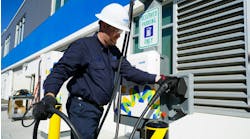Electric vehicle (EV) adoption continues to grow rapidly — with the Edison Electric Institute projecting that nearly 22 million electric vehicles will be on U.S. roads by 2030. Electrical professionals are preparing for the increase in vehicle electrification and the infrastructure needed to support it. Yet not all EV charging applications are created equal. The evolving landscape of EV adoption makes it imperative for electrical professionals tasked with installing EV charging equipment in residential applications to consider important factors such as capacity, safety, configuration and grid interactive infrastructure.
We’ll explore some of these factors in the coming months with an article series focused on EV charging installation considerations, beginning with the issue of energy capacity.
The capacity conundrum
One of the most critical elements of EV charging now and in the future is capacity — namely, the available energy capacity to meet vehicle charging requirements. EV purchasers will install a charger in their homes, plug in their vehicles, and expect energy to be available to maintain the level of charge needed for their daily travels. Available capacity will play a major role in meeting this expectation, and electrical professionals will have an opportunity to help vehicle owners understand why.
“Capacity is one of the least understood aspects of EV charging, and I believe it is one of the biggest opportunities for education moving forward,” said Adam Schmitt, commercial service electrician at Ferry Electric Company in Pittsburgh. “Most of our customers wouldn’t think to ask questions about capacity, but as an electrician, it’s one of the first things I think about when installing equipment.”
Before proceeding with residential installations, contractors should ask the following questions.
What are the vehicle’s charging requirements?
The primary type of charger installed in single-family homes is a Level 2 AC charger, which provides 240V of power, ranging from 3.3kW to 19.2kW. With any Level 2 charger (however, charging speed will be limited by and dependent on the vehicle’s onboard charger). Other variables that impact charging speed can include extreme weather (batteries won’t charge quickly when they are too hot or too cold) as well as the current charge level of the battery (batteries will typically charge faster when they are at a low state of charge).
The maximum rate of a charging session is determined by the lower of the capacity of the vehicle or the charging station. This is important to understand, as many vehicle owners may purchase a charger that can deliver 60A or even 100A, but only have the onboard vehicle capacity to charge at 32A. In this instance, electrical professionals should make it clear to homeowners what available capacity will deliver. For example, with a 32A charger, the vehicle may require 12 hours of charge time vs. six hours with a 60A charger for the same 80kWh charge.
Does available energy capacity exist at the grid level to meet these requirements?
This is a major factor when considering the installation of charging infrastructure because regardless of onboard charging capacity or the capabilities of the infrastructure itself, the ability to charge will only be as good as the availability of the energy supplying it.
Let’s say an average American neighborhood has approximately nine 50kVA transformers and six 25kVA transformers supplying a total of 600kVA (9 × 50kVA + 6 × 25kVA) to 100 single-family homes or 6kVA per home. If the typical load for a home on average is 3kVA to 5kVA, then the transformers can easily support the capacity required for those loads. Add EV charging into the mix, however, and those loads will soon grow considerably, especially when multiple vehicles are charging simultaneously on a single transformer. In many neighborhoods, as many as six to eight homes share a single 50kVA transformer with 208A capacity. Add in 30A to 50A per electric vehicle charger in a home, and those homes can easily reach that capacity regardless of the electrical size of the load centers in the home.
This may not seem like a concern today as only 5.8% of U.S. vehicle sales in 2022 were electric. But that number is expected to rise quickly — S&P Global Mobility expects it to jump to 40% by 2030, and more optimistic projections see that number surpassing 50%. Those additional vehicles may quickly put a strain on grid capacity. Fortunately, electrical professionals can start preparing for the increase in demand now.
What can be done to offset capacity challenges?
By understanding the multitude of capacity challenges that may exist, electrical professionals can take steps to help enable a smooth transition to EV infrastructure.
One step is to add battery energy storage along with solar energy to help supplement available grid capacity. Homeowners may be able to access available government and electric utility incentives to help offset the added cost of solar and storage adoption. Deploying battery storage can help provide an additional source of power when grid capacity is low, particularly for charging at times when usage is highest in the neighborhood.
Another step electrical professionals can take is to advise homeowners to proactively call their electric utilities and ask informed questions about the capacity that exists today and how that may change as more homes in their neighborhoods adopt EVs. More communication between homeowners and electric utilities is always beneficial and can only help electric utilities manage potential concerns while strengthening their customer relationships as EVs continue to transform the grid.
Finally, electrical professionals can lead the way in helping homeowners better manage home energy usage. Effective home energy management will be essential as more homes become electrified. With available tools like smart home apps, smart circuit breakers, and connected wiring devices, homeowners can incorporate vehicle charging equipment into their overall smart energy ecosystem to enable a better charging experience.
Concluding thoughts
The common thread in addressing capacity challenges with EV charging is education. As with any major purchase, an EV is a significant investment, and it’s important to equip homeowners with the right information while taking steps to deliver a charging experience that helps them maximize the value of that investment.
The EV revolution is here. Electrical professionals should prepare now in advance to the inevitable wave of residential charging infrastructure installations that will be required to meet demand. Understanding where potential capacity issues exist and working with homeowners to address these challenges will go a long way toward streamlining adoption.
Dan Carnovale is the director of the Eaton Experience Centers in Pittsburgh and Houston. He is a registered Professional Engineer in the states of Pennsylvania, California and Alaska, a Certified Energy Manager (CEM) and a Senior Member of IEEE. He can be reached at [email protected].
About Eaton Experience Centers
At Eaton’s Experience Centers, visitors learn about industry best practices and the latest innovations through hands-on training in multiple application environments. The Eaton Experience Center in Pittsburgh is a full-scale demonstration and testing facility where visitors can see firsthand the latest advances in electrical power quality, energy management and safety. In this controlled environment, visitors observe product testing and performance, participate in live demonstrations and training courses, and learn about power management technologies from Eaton experts. The goal of Eaton’s Experience Centers is to help take the mystery out of electrical power systems spanning from utility substation equipment to the receptacles in the home. To learn more, visit Eaton.com/Experience.





